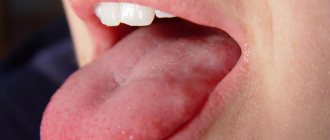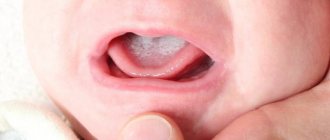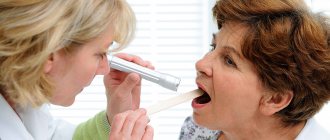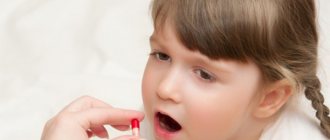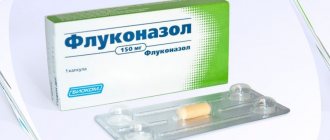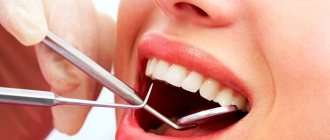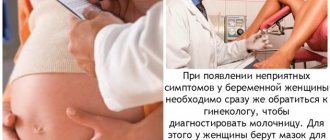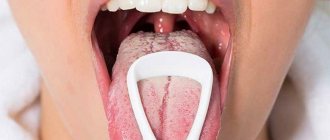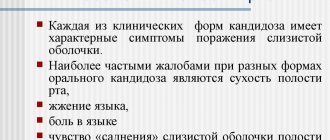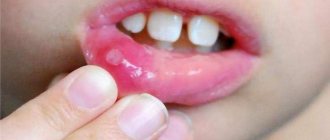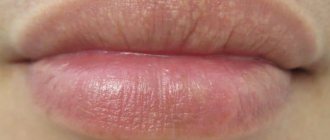Candidiasis is a disease that is caused by a fungus of the genus Candida; it affects the mucous membrane, skin, and internal organs. Atrophic oral candidiasis is one of the types of this infection, which can be acute or chronic. The human mouth contains many different bacteria and fungi. If a person is healthy, then these microorganisms do not cause any concern. When the immune system is weakened, control over this microflora is lost, and the number of microorganisms increases significantly, which provokes a fungal disease.
Treatment of thrush (candidiasis) with antifungal drugs
For acute superficial forms of the disease, topical antimiotics are used; for severe, including chronic forms of candidiasis, systemic action (through the bloodstream) is used. For local treatment, drugs are used in the form of ointments, creams, liniments, solutions, lotions, gels, sprays, powder, powder, vaginal suppositories and tablets. Some of them contain hormones and antibacterial drugs. For severe symptoms and complicated course of candidiasis, systemic antimiotics are used in the form of tablets and solutions for intravenous administration.
- In uncomplicated forms of thrush, courses of systemic therapy are short, in complicated forms they are doubled; in chronic cases of candidiasis, antifungal drugs are used for a long time. In some cases, simultaneous use of antimiotics locally and orally is indicated.
- When treating thrush of the mucous membranes and skin, antiseptics are additionally used.
- Before starting treatment, it is necessary to identify and eliminate the factors leading to the development of the disease and carry out corrective therapy.
- For widespread and chronic forms of the disease, pathogenetic therapy is prescribed.
- Treatment of genital thrush should be combined with treatment of thrush in a sexual partner.
Rice. 2. Rapid formation of pseudomycelium of the fungus (filamentous form) is an indicator of the parasitic activity of microorganisms.
Acute atrophic candidiasis of the oral cavity
Acute atrophic candidiasis of the oral cavity, in contrast to pseudomembranous candidiasis, is characterized by severe pain, burning and dry mouth. With this type of candidiasis, atrophic processes prevail, as a result of which the mucous membrane becomes bright red and dry.
The presence of plaque in atrophic candidiasis is not typical. However, in some cases, white plaque patches with candida micelles can be detected. Most often, these foci of plaque are localized in deep folds and adhere tightly to the mucous membrane.
Antifungal drugs
The following groups of antimiotics are used in the treatment of candidiasis:
- Imidazole derivatives (Miconazole, Ketoconazole, Isoconazole, Omoconazole, Clotrimazole, Econazole, Bifonazole, Oxiconazole, Butoconazole, Sertaconazole (Imidazole + Benzothiophen). Imidazole derivatives block the production of the substance ergosterol, which the cell uses to build its wall. In this case, the wall becomes “leaky” , the contents of the cells “leak out”, which leads to its death.
- A group of polyene antibiotics (Nystatin, Levorin, Natamycin, Amphotericin and Pimafucin) are widely used in the treatment of candidiasis. Amphotericin is used in the treatment of systemic fungal infections.
- Triazoles (azole compounds) (Fluconazole, Itraconazole) are the main ones in the treatment of various forms of candidiasis.
- Other antimyotics (Flucytosine, Dequalinium chloride, Decamine, Chlornitrophenol, iodine preparations, etc.).
Rice. 3. Under the influence of antifungal drugs, the shell of mushrooms becomes porous, “leaky.” On the left you can see how the contents of the cell flow out onto the surface of the mycelium.
For the systemic treatment of thrush, the drugs used are triazole, fluconazole and intraconazole.
- Fluconazole (Tsiskan, Diflucan, Difluzon, Medoflyukan, Mycoflucan, Forkan, Flucostat, Fucis, Flunol, Fluzak, Diflazon, Mikosist, Mikomax). Medicines containing Fluconazole are the “gold standard” in the treatment of patients with candidiasis. They are highly effective, well tolerated, poorly metabolized by the liver, and cause minimal side effects with long-term use. Fluconazole is effective in the treatment of patients with normal and reduced immunity; it is used for torpid candidiasis. Together with Amphotericin, it is used in the treatment of meningitis and sepsis of a fungal nature.
- Intraconazole (Intrazol, Orungal, Orungamin, Intraconazole-ratiopharm, Irunin, Rumikoz).
Rice. 4. The photo shows fungi of the genus Candida albicans under a microscope.
Structure and reproduction
What does Candida look like? Fungi of the genus Candida have a somewhat elongated shape and, under favorable conditions, are capable of forming false mycelium (mycelium), consisting of elongated cells. The peculiarities of Candida representatives include the fact that they are capable of forming only chlamydospores, which are not true spores, but, nevertheless, have an improved defense mechanism. In fact, this form of existence of candida resembles the cysts formed by some bacteria: chlamydospores have a dense outer shell that protects the fungus from aggressive environmental factors.
Spores play a significant role in the spread of candida, since in this form the fungus can remain viable in the environment for a long time until it enters the body of a new host. Fungi reproduce by budding. Candida mushrooms, like many others, are sensitive to the acid-base balance and are able to change it in their favor. The most favorable conditions for the development of microorganisms are slightly alkaline or neutral, therefore, answering the question “what is Candida afraid of?”, we can say that the fungus dies in an acidic environment.
Local treatment of thrush
Most cases of thrush are treated with antifungal medications and topical antiseptics. They create high concentrations of therapeutic agents in the affected area, have a low degree of absorption (absorption into the general bloodstream), are safe to use, and resistance rarely develops with their use. Local antimiotics provide rapid relief of symptoms of the disease. They are available in the form of ointment, cream, powder, solution, gel, spray, vaginal suppositories and tablets. They often contain hormones and antibiotics.
The tables presented below list antifungal drugs of different groups and their release forms, registered in the Russian Federation.
I. Imidazole derivatives for topical treatment of thrush
Contains miconazole
- Cream Daktarin, Mykozon, Lanaderm.
- Oral gel Daktarin.
- Tablets for resorption in the mouth Miconazole nitrate.
- Aerosol Daktarin.
- Daktarin powder.
- Spray powder Daktarin.
- Vaginal suppositories Ginezol-7, Gino-Mikozal, Daktarin, Daktanol, Gino-Daktanol, Gino-Perival, Ginodaktarin. Klion-D and Klion-D100 (Metronidazole + Miconazole), Neo-Penotran.
- Vaginal cream Ginezol-7, Gino-Mikozal, Miconazole.
- Vaginal tablets Klion-D and Klion-D100 (Metronidazole + Miconazole), Neo-Penotran.
Contains ketoconazole
- Ointment Mycozoral, Mycoket, Sebozol.
- Cream Mycozoral, Mycoket, Nizoral, Dermazol.
- Liniment Sebozol.
- Vaginal suppositories Ketoconazole, Ketoconazole Altfarm, Livarol.
Contains econazole
- Econazole ointment.
- Cream for external use Ifenek, Ekalin, Ecodax, Ecomikol
- Econazole gel, Travocort cream (contains glucocorticoid and isoconazole).
- Aerosol Ekalin, Ecomikol.
- Ifenek solution.
- Ifenek powder.
- Vaginal suppositories Ifenek, Gino-Pevaril, Ekalin, Ecomikol, Econazole, Gino-Pevaril 150.
- Vaginal cream Ecomikol.
Contains clotrimazole
- Ointment Clotrimazole, Clotrimazole Acri, Katrizol, Funginal, Fungizid-Ratiopharm.
- Cream Candide, Clofan, Clotrimazole, Clotrimazole Acri. Katrizol, Candibene, Candide B1, Candibene.
- Gel Candide, Fungizide-Ratiopharm, Canestin, Lotrimin, Faktodin, Amyclone, Clotrimazole-Teva, Lotrimin.
- Lotion Candide, Clofan, Fungizid-Ratiopharm.
- Aerosol Clofan, Clotrimazole, Clotrimazole Acri, Fungizid-Ratiopharm.
- Candide solution, Clofan, Katrizol, Funginal, Candibene, Candide B1
- Powder Candide, Funginal. Kandibene, Candide B1.
- Vaginal cream Katrizol, Funginal, Fungizid-Ratiopharm, Funginal V, Fungitsip, Gine-Lotrimin, Gine-Lotrimin, Imidil, Kanizon.
- Vaginal tablets Candide, Clotrimazole, Clotrimazole Acri, Katrizol, Funginal, Fungizid-Ratiopharm, Candibene, Candibene, Candide B1, Funginal B, Fungitsip, Gine-Lotrimin, Gine-Lotrimin, Imidil, Kanizon, Antifungol, Candide B6, Candizol, Yenamazol, Yenamazole 100, Yenamazole 200, Menstan.
Combination drugs containing clotrimazole:
- Clomegel (Clotrimazole + Metronisazole) and Metrogyl Plus (Clotrimazole + Metronisazole) in the form of a vaginal gel.
- Beta-Mycoter and Candide B (clotrimazole + glucocorticoid) in the form of a cream for external use.
- Triderm, Akriderm GK and Candiderm (clotrimazole + glucocorticoid + antibiotic gentamicin) in the form of a cream for external use.
- Clomesol (clotrimazole + antibiotic neomycin + antimicrobial drug metronidazole) in the form of vaginal suppositories.
Other imidazole derivatives
- Cream for external use Zalain and Sertaconazole (contains sertaconazole), Micogal (contains omoconazole), Mifungar and Gino-Mifungar (contains oxyconazole), Travogen (contains isoconazole), Travocort (contains isoconazole and glucocorticoid). Mycospor and Bifosin (contains bifonazole).
- Mycospor ointment.
- Solution for external use Sertamicol, Bifosin and Mikospor.
- Bifosin powder.
- Vaginal suppositories Zalain (Sertaconazole), Optiginal, Omoconazole, Gyno-travogen, Gyno-Travogen® ovulum, Fenticonazole, Lomexin, Mycogal.
- Vaginal cream Butoconazole. Fenticonazole, Lomexin.
- Vaginal tablets Gino-Mifungar (oxiconazole).
II. Group of polyene antibiotics for local treatment of thrush
Contains ternidazole
- Vaginal tablets Terzhinan (ternidazole + nystatin + prednisolone).
Contains nystatin
- Ointment, vaginal and rectal suppositories Nystatin.
Contains levorin
- Ointment, lyophilisate for the preparation of solutions, suspension, tablets for resorption in the mouth, vaginal tablets Levorin.
Contains natamycin
- Cream for external use Pimafucin.
- Vaginal suppositories Natamycin, Ecofucin, Pimafucin.
- Vaginal cream Pimafucin.
- Combined drug Pimafucort (natamycin + hydrocortisone + neomycin) in the form of cream and ointment.
Contains amphotericin
- Amphotericin B ointment.
- Lyophilized powder for the preparation of a solution for intravenous administration and inhalation Amphotericin B, Ampholip, Amphocil, Fungizone, Fungilin.
III. Other antifungal drugs for topical treatment of thrush
Contains Chloronitrophenol (antifungal)
- Solution for external use Nitrofungin, Nitrofungin-Teva.
Synthetic allylamine derivatives
- Terbinafine ointment (active ingredient terbinafine).
- Cream Terbinafine, Lamisil, Exiter, Exifin, Terbizil, Termicon, Naftifine, Fugnoterbin (terbinafine). Cream Batrafen (ciclopirox).
- Gel Terbinafine, Naftifine, Lamisil Dermgel, Exifin.
- Spray Terbinafine, Thermikon, Fugnoterbin, Lamisil.
- Solution for external use Nitrofungin and Nitrofungin-Teva (contain chloronitrophenol). Exoderil (naftifine).
Olamine derivatives
- Batrafen cream (contains ciclopirox).
- Vaginal cream and suppositories Dafnegin (ciclopirox).
Treatment of thrush with general and local antifungal drugs should only be done under the supervision of a physician. Do not self-medicate or self-diagnose. Read the instructions carefully before using the medicine.
Rice. 5. Formation of pseudomycelium of the fungus on the surface of the skin and mucous membranes.
Treatment of thrush with antiseptics
Many years of experience have been accumulated in the use of antiseptics of different groups in the treatment of superficial forms of candidiasis. They are active against viruses, bacteria, fungi and protozoa. Available in different forms of medicines.
- Dyes: aqueous and alcoholic solutions of Gentian violet, Brilliant green, Methylene blue and Fuchsin in Castellani liquid.
- Acids: Salicylic (Whitefield and Arievich ointment), Benzoic (Whitefield ointment) and Boric acid (Castellani liquid and Teymurov paste).
- Phenols: Resorcinol (ointment, alcoholic and aqueous solutions) and Phenol (carbolic acid) are included in Castellani liquid and Fucorcin solution.
- Quinolines: Quinozol (ointment and patch) and Clioquinol (complex ointments). Lorindem S ointment contains glucocorticoid and clioquinol.
- Oxidizing agents: Potassium permanganate solution is used for damage to the skin, oral mucosa, colpitis and urethritis (washing, spinning).
- Zinc oxidizers: Zinc oxide (ointments, pastes, powders).
- Iodine preparations: Iodine (alcohol solutions 1 - 3%) and Povidone-iodine (solution and ointment for external use, vaginal suppositories and tablets, soap). Lugol's solution with spray.
- Dequalinium chloride (ammonium compound). Dequalinium chloride and Fluomizin (ointment, lozenges, vaginal tablets), Laripront (lozenges).
- Miramistin (benzyldimethyl). Available in the form of a solution with a gynecological spray (vaginal spray) and an applicator for injection into the urethra.
- Chlorhexidine bigluconate (gel for topical use, solution for irrigation, rinsing, applications, including injections into the urethra). Hexicon in the form of a solution for external use, vaginal suppositories and tablets.
- Copper sulfate solution. It is used externally in the form of a solution for washing with vaginitis and urethritis, and irrigation of the pharynx.
- A solution of sodium tetroborate in glycerin (Borax). It is used externally for skin lesions (lubrication), vaginal candidiasis (douching, using cotton swabs), oral thrush (irrigation of the pharynx, lubrication with a cotton swab in children).
Rice. 6. Thrush in men and women.
Chronic atrophic candidiasis of the oral cavity
Chronic atrophic candidiasis of the oral cavity is also called 'candidiasis of the denture bed', since this type of candidiasis often affects the mucous membrane under the denture. The mucous membrane becomes hyperemic and edematous. Patients complain of pain and dry mouth.
A characteristic feature of chronic atrophic candidiasis of the oral cavity is that, in parallel with the mucous membrane, the tongue and corners of the mouth are affected. The tongue, due to atrophy of the papillae, becomes bright red and shiny, and candidal (mycotic) lesions form in the corners of the mouth.
Pathogenetic treatment of candidiasis
Many years of experience in the treatment of candidiasis indicate that in addition to influencing fungi of the genus Candida, it is necessary to influence all factors in the development of the disease. Complex treatment of mycosis should be aimed at correcting the patient’s immune status, reducing sensitization and restoring the intestinal biocenosis, which can significantly increase the effectiveness of treatment and help achieve lengthening periods of remission.
Desensitization therapy
In order to reduce sensitization, it is recommended to take new generation antiallergic drugs: Zodak Express, Loratek, Erius, Loratek, Dezal, Telfast. Fexofast, Fexofen, etc.
Increasing the body's immunological resistance
With candidiasis, the absorption of vitamins and microelements, including iron, is impaired.
- For replacement purposes in case of illness, it is recommended to take Ferroglobolin B12. The composition of the drug includes B vitamins (B1, B2, B3, B6 and B12), folic acid, vitamin C, pantothenic acid, calcium glycerophosphate, iron ammonium citrate, zinc, manganese, copper, iodine, lysine, honey and root extract licorice.
- Bactistatin dietary supplement contains:
- Bacillus subtilis metabolites inhibit opportunistic and pathogenic intestinal microflora, promote complete digestion, and increase the body's defenses by stimulating the synthesis of interferon.
- Zeolite is a natural sorbent. Selectively absorbs and removes allergens and toxins, thereby helping to reduce various types of toxicosis. When exposed to it, intestinal motility is normalized, bloating and spastic phenomena are reduced.
- Soy flour hydrolyzate is a prebiotic component. It promotes the growth and restoration of normal intestinal microflora.
- For low hemoglobin levels in the blood, iron preparations are used: Ferroplex, Iron lactate, Iron glycerophosphate, Hemostimulin.
Fighting hypoproteinemia
In chronic cases of candidiasis, patients experience hypoproteinemia (decreased protein in the blood plasma). In order to normalize nitrogen metabolism, patients are prescribed anabolic steroids: Inosine, Nandrolone, Orotic acid, Methyluracil, etc.
Diet for candidiasis
Diet during illness should be limited in carbohydrates. Yeast-like fungi of the genus Candida prefer to live in tissues rich in internal sugar - glycogen.
Immunocorrection
In case of proven functional and quantitative deficiency of T- and B-lymphocytes, immunomodulators are prescribed: Sodium Nucleinate, Splenin, Taktivin, Arbidol, Levamisole, Splenin, Methyluracil, etc. To correct humoral immunity, human immunoglobulin, gamma globulin, etc. are used.
Detoxification
In severe, common forms of candidiasis, hemodez infusions are used for detoxification.
Rice. 7. Thrush in women.
Complex treatment of candidiasis (thrush) allows you to maintain the normal functioning of patients. They can study, work, start a family and have children.
Symptoms of candida in the intestines
Any shift in the internal balance of the body can lead to active proliferation of the fungus. It becomes dominant and suppresses the beneficial intestinal microflora, disrupting the normal enzymatic activity of the gastrointestinal tract and negatively affecting the absorption of most nutrients. Candida infection in the intestines is manifested by the following symptoms:
- Bloating and increased gas formation;
- Disturbance of defecation: stool becomes infrequent, but liquid, possibly foamy;
- The appearance of abdominal pain of varying severity.
As the disease becomes chronic, the symptoms become more pronounced, a serious imbalance of micro- and macroelements is added to them, and waste products of the fungus accumulate in the body, which are poisonous to humans. All this leads to inflammation of the intestines, deterioration of its functions, disruption of peristalsis and enzymatic activity. Against the background of weakened immunity, concomitant diseases (for example, gastroenteritis) may develop.
Treatment of candidiasis of smooth skin
To treat skin candidiasis, antifungal drugs and antiseptics are used in the form of cream, ointment, liniment, solution, lotion, gel, powder, powder and spray. Medicines are applied to previously cleansed skin areas using soap with a neutral pH in a thin layer.
Characteristics of the main forms of medicines
- Cream, ointment. Apply a 1 cm column of the medicine to a palm-sized affected area and rub in easily. If necessary, an occlusive dressing is applied. If the interdigital spaces are affected, a gauze pad soaked in cream is placed between the fingers.
- Solution. Antifungal drugs in the form of a solution are applied to previously cleansed (using soap with a neutral pH) and dried areas of the skin. Apply 10 - 20 drops of solution to a palm-sized affected area, 3 - 4 drops of solution to small surfaces. If necessary, an occlusive dressing is applied. The solution can be combined with cream.
- Aerosol. Antimiotics in aerosol form are sprayed onto the skin from a distance of 10 cm until lightly moistened.
- Spray powder. To treat superficial candidiasis, spray powder (spray powder) is used. Spraying is carried out from a distance of 8 cm.
Antifungal drugs and antiseptics for the treatment of candidiasis are listed in the table above.
In the chronic form of candidiasis or common processes, in addition to local treatment, systemic antimiotics of the triazole, imidazole group, polyene antibiotics and pathogenetic therapy are used (see above).
Rice. 8. Thrush in the inguinal fold (photo on the left) and armpits (photo on the right).
List of antimiotics of different groups for the treatment of skin thrush
Imidazole derivatives for topical treatment of thrush
Contains miconazole:
- Cream Daktarin, Mykozon, Lanaderm.
- Tablets for resorption in the mouth Miconazole nitrate.
- Aerosol Daktarin.
- Daktarin powder.
- Spray powder Daktarin.
Contains Ketoconazole:
- Ointment Mycozoral, Mycoket. Sebozol.
- Cream Mycozoral, Mycoket. Nizoral, Dermazol.
- Liniment Sebozol.
Contains Econazole:
- Econazole ointment.
- Cream for external use Ifenek, Ekalin, Ecodax, Ecomikol
- Econazole gel, Travocort cream (Diflucan + Isoconazole) contain glucocorticoid and isoconazole.
- Aerosol Ekalin, Ecomikol.
- Ifenek powder.
- Ifenek solution.
Contains Clotrimazole:
- Ointment Clotrimazole, Clotrimazole Acri, Katrizol, Funginal, Fungizid-Ratiopharm.
- Cream Candide, Clofan, Clotrimazole, Clotrimazole Acri. Katrizol, Candibene, Candide B1, Candibene.
- Gel Candide, Fungizide-Ratiopharm, Canestin, Lotrimin, Faktodin, Amyclone, Clotrimazole-Teva, Lotrimin.
- Lotion Candide, Clofan, Fungizid-Ratiopharm.
- Aerosol Clofan, Clotrimazole, Clotrimazole Acri, Fungizid-Ratiopharm.
- Candide solution, Clofan, Katrizol, Funginal, Candibene, Candide B1
- Powder Candide, Funginal. Kandibene, Candide B1.
- Triderm and Akriderm GK (clotrimazole + glucocorticoid + antibiotic gentamicin) in the form of cream and ointment.
- Candiderm (clotrimazole + glucocorticoid + antibiotic gentamicin) in the form of a cream for external use.
Other imidazole derivatives
- Cream for external use Zalain and Sertaconazole (contains sertaconazole), Micogal (contains omoconazole), Mifungar and Gino-Mifungar (contains oxyconazole), Travogen (contains isoconazole), Travocort (contains isoconazole and glucocorticoid). Mycospor and Bifosin (contains bifonazole).
- Mycospor ointment.
- Solution for external use Sertamicol, Bifosin and Mikospor.
- Bifosin powder.
Group of polyene antibiotics for local treatment of thrush
- Ointment Nystatin, Levorin, Amphotericin B.
- Cream Pimafucin.
- Lyophilisate for preparing Levorin solutions.
Other antifungal drugs for topical treatment of thrush
Contains Chlornitrophenol (antifungal):
- Solution for external use Nitrofungin, Nitrofungin-Teva.
Synthetic allylamine derivatives:
- Terbinafine ointment (active ingredient terbinafine).
- Cream Terbinafine, Lamisil, Exiter, Exifin, Terbizil, Termicon, Naftifine and Fugnoterbin (contain terbinafine). Batrafen (ciclopirox).
- Gel Terbinafine, Naftifine, Lamisil Dermgel, Exifin.
- Spray Terbinafine, Thermikon, Fugnoterbin, Lamisil.
- Solution for external use Nitrofungin and Nitrofungin-Teva (contain chloronitrophenol). Exoderil (naftifine).
Olamine derivatives:
- Batrafen cream (contains ciclopirox).
- Vaginal cream and suppositories Dafnegin (ciclopirox).
In cases where thrush occurs with severe symptoms of inflammation and/or the addition of a secondary infection, it is recommended to use combined medications in the form of a cream containing, in addition to an antimyotic, a hormonal drug and/or an antibiotic:
- Beta-Mycoter and Candide B (clotrimazole + glucocorticoid) in the form of a cream for external use.
- Triderm and Akriderm GK (clotrimazole + glucocorticoid + antibiotic gentamicin).
- Candiderm (clotrimazole + glucocorticoid + antibiotic gentamicin) in the form of a cream for external use.
- Travocort (contains glucocorticoid and isoconazole).
- Triderm and Akriderm GK (clotrimazole + glucocorticoid + antibiotic gentamicin).
- Candiderm (clotrimazole + glucocorticoid + antibiotic gentamicin).
Antiseptics are widely used for candidiasis of the skin and mucous membranes (see above). In case of chronic form of candidiasis or common processes, in addition to local treatment, systemic antifungal drugs of the triazole, imidazole group, polyene antibiotics and pathogenetic therapy agents are used (read above).
Rice. 9. The photo shows thrush of the skin of the interdigital folds on the hand and foot.
Treatment of candidiasis of the skin of the nail folds
Treatment of the skin of the nail folds begins with eliminating the acute inflammatory process. Ichthyolol ointment has a good effect, which is used in the form of applications until a positive effect is obtained. Next, antifungal drugs are prescribed for topical use in the form of an ointment, cream or solution using an occlusive dressing. Antiseptics are widely used for the disease.
In the chronic form of candidiasis or common processes, in addition to local treatment, systemic antimiotics of the triazole, imidazole group, polyene antibiotics and pathogenetic therapy are used (see above).
Rice. 10. The photo shows candidiasis of the nail fold. The initial stage of damage to the nail plate.
Treatment of thrush in men and women
In the treatment of thrush in women and men, antimiotics and antiseptics are used in the form of vaginal cream, gel, vaginal tablets and suppositories, solutions and sprays.
- Vaginal suppositories (suppositories) are inserted deep into the vagina (posterior fornix) in the “lying down” position once a day at night. Before using suppositories, the external genitalia are washed using alkaline or neutral soap. In some people, the ethanol contained in the drug may cause a hypersensitivity reaction.
- Vaginal tablets are inserted deep into the vagina after douching with a 0.5 - 1% sodium bicarbonate solution and drying with a cotton-gauze swab. Before administration, the tablet is moistened with water. During menstrual cycles, treatment is stopped.
- Vaginal cream and gel are inserted using an applicator deep into the vagina while lying on your back with legs bent in portions of 5 grams. and is used externally.
- Solutions are used to wash the genitals. They are prepared the day before and used 1 - 2 times a day for 3 - 5 days.
The list of medications of different groups and forms for the treatment of thrush in men and women is described in the table above.
In the chronic form of thrush, in addition to local treatment, systemic antifungal drugs of the triazole, imidazole and polyene antibiotics group and pathogenetic therapy are used.
For thrush in women and men, the following antiseptics are used:
- Miramistin solution (vaginal spraying and injection into the urethra).
- Resorcinol solution (topically for vaginitis and urethritis).
- Copper sulfate solution (for rinsing with urethritis and vaginitis).
- Dequalinium chloride (vaginal tablets).
- Povidone-iodine (vaginal suppositories and tablets, soap).
- Sodium tetroborate solution in glycerin (Borax). It is used externally for skin lesions (lubrication), vaginal candidiasis (douching, using cotton swabs).
- Chlorhexidine bigluconate solution for injection into the urethra and insertion into the vagina.
In cases where thrush occurs with severe symptoms of inflammation and/or the addition of a secondary infection, it is recommended to use combination medications containing, in addition to the antimiotic, a hormonal drug and/or an antimicrobial agent:
- Clomegel (Clotrimazole + Metronisazole) in the form of a vaginal gel.
- Metrogyl Plus (Clotrimazole + Metronizazole) in the form of a vaginal gel.
- Clomesol (clotrimazole + antibiotic neomycin + antimicrobial drug metronidazole) in the form of vaginal suppositories.
- Klion-D, Klion-D100 (Miconazole + Metronidazole) vaginal tablets and suppositories.
During the treatment of thrush, women and men should abstain from sexual intercourse.
For more information on the treatment of genital candidiasis in women and men, see the article “All about thrush in women” and “All about thrush in men.”
Rice. 11. Thrush in men.
Treatment of respiratory tract candidiasis
For fungal infections of the respiratory tract, antifungal drugs containing Amphotericin are used:
- Ambisome (contains liposomal Amphotericin). Used for intravenous administration.
- Ampholip, Amphocil, Fungizon, Fungilin (lyophilized powder for the preparation of solution for intravenous administration and inhalation).
- Amphoglucamine (Amphotericin B + Meglumine) tablets.
- Amphotericin B (ointment and lyophilized powder for the preparation of solution for intravenous administration and inhalation).
Levorin is used in inhalation form.
Rice. 12. Candidal pneumonia.
Treatment of common forms of candidiasis
Systemic candidiasis develops in individuals with severe immunodeficiency and endocrine disorders. The decisive factor is long-term therapy with antibiotics, corticosteroids and immunosuppressants. Pathogenetic and symptomatic therapy are used.
Treatment of chronic generalized candidiasis
Treatment of common chronic forms of candidiasis should be comprehensive and include systemic and local antifungal drugs, pathogenetic therapy. It is necessary to identify factors that reduce immunity and, if possible, eliminate them. Treatment with antimiotics is carried out in courses with breaks of 7 - 14 days. The duration of treatment is strictly individual. In some cases it is 1 year or more. Treatment of chronic forms of candidiasis requires great patience between the doctor and the patient.
Rice. 14. Chronic generalized candidiasis.
The best remedy for candidiasis
Most often, when candidiasis is confirmed by laboratory tests, patients are prescribed the antifungal drug fluconazole. The medicine is used not only when Candida microorganisms are detected in biological materials, but also pathogens of other species.
Fluconazole differs from other fungicidal drugs in its maximum activity against fungi. The active substances of the drug block the synthesis of enzymes by microorganisms, preventing their further reproduction. The fluconazole component has the ability to be uniformly distributed in tissues and accumulate in the skin. The antimycotic is effective in severe forms of candidiasis, which is accompanied by damage to internal organs, respiratory and urinary tracts. The medicine can help with fungal infections of the nail plates, mucous membranes of the eyes, and the oral cavity.
Vaginal and urogenital candidiasis are treated with a single dose of 150 mg tablet. To prevent exacerbations, your doctor may prescribe you to take fluconazole again. If the oral cavity and digestive tract are affected, the course is 2-4 weeks.
For taking tablets for preventive purposes, the dosage is calculated individually.
Prevention of thrush (candidiasis)
Prevention of thrush (candidiasis) should be carried out in several directions:
- Elimination of factors contributing to the development of candidiasis (treatment of diabetes mellitus, endocrine pathology, etc.). Women should not abuse hormonal contraceptives.
- Compliance with personal hygiene rules.
Prevention of thrush in children
- Thorough disinfection of dishes and linen in maternity hospitals.
- Treatment of foci of disease in pregnant and nursing mothers.
- Monitor medical personnel caring for children for signs of illness.
- Promptly isolate sick children.
Prevention of thrush (candidiasis) in medical institutions
- Combating the prescription of irrational (unjustified) antibiotic therapy.
- Carefully treats patients with immunodeficiencies.
- In people at risk (including those taking corticosteroids), antibiotics should be taken together with the antimyotic Levorin and B vitamins.
- The use of hormonal therapy is strictly according to indications.
